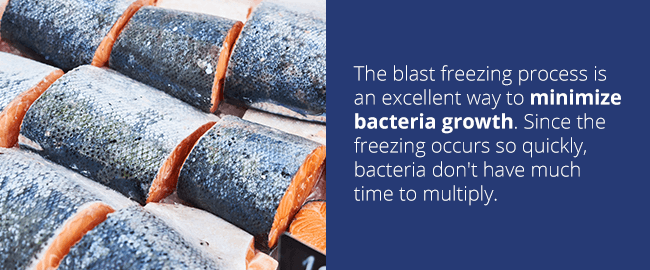If you’ve ever wondered exactly how sushi is transported or how fish is kept fresh, look no further. We will walk you through the process of blast freezing and go over the benefits of fresh vs. frozen fish.
What is Blast Freezing?
Blast freezing is one of the most versatile methods of food preservation. For seafood, blast freezing provides a level of taste, texture and presentation unlike any other method. Most of this is due to the speed at which the product is frozen. The general process for blast freezing involves pushing cold air across the fish at a very high velocity and a very low temperature. Freezers can have a variety of sizes and configurations. Some include conveyor belts or moving trays, while others can be used as long-term storage or transportation solutions. Blast freezing applies to more than just seafood.
The way that these freezers work is connected to the way that water freezes within the cells of the fish. When fish freeze, the water molecules within the cells bond with each other to form ice. As the water molecules start to freeze, they move toward other molecules to form specific patterns. When the molecules pull away from the cells, they leave higher concentrations of enzymes and electrolytes that damage the cell walls. If the freeze time is slow, this movement can damage the cells much more than it would during a fast freeze because of the large size of the ice crystals. When they freeze quickly, the molecules don’t have time to reposition themselves and smaller crystals form. Large clumps of ice don’t develop, and the enzymes and electrolytes stay isolated, causing less damage to the cells. With this process, a thawed product more closely resembles the fresh version in taste, color, texture and even the nutrients that are locked in.
Temperatures tend to reach about -34°C (-30°F) in a blast freezer, but some can get much colder.
Benefits of Blast Freezing Seafood
There are several reasons you might use blast freezing for seafood, which can be anywhere from 60 to 80% water. The high water content makes it especially susceptible to the cell-damaging parts of the freezing process. Plus, the better results of a blast freezer can benefit the company, the consumer and the health of the general population. If that wasn’t enough, the improved taste, texture and overall quality make the blast freezer an attractive piece of equipment for anyone involved in food production.
- Fast and efficient: One of the most notable benefits to blast freezers is that they are fast. For any business that relies on production speeds, fast freezing can be a substantial asset. By moving more product through the freezer, you make room for the next batch sooner. You can also process orders quicker.
- High-quality product: If your seafood thaws to a near-fresh state, you can bump it into a higher-priced market and collect more for each product sold. Blast-frozen fish sees less wilting or mushiness from the thawing process. The improved quality is partly because of the previously mentioned ice crystal formation, but also because of the way the airflow pattern breaks up any heat gradients. Typically, a fast airflow over the surface of the fish would cause it to dehydrate, but by developing a frozen skin on the edges, a blast freezer can prevent this, keeping the fish fresh on thawing.

- Safer: The blast freezing process is an excellent way to minimize bacteria growth. Normally, bacteria growth occurs between 4°C (40℉) and 60°C (140℉). Since the freezing occurs so quickly, bacteria don’t have much time to multiply. The food remains free of these microorganisms. Blast freezing is helpful from a business standpoint, as it keeps you safe from creating health hazards in your product, and it helps keep the general public healthy. This factor is especially necessary for meat and seafood applications.
- Healthier: Speaking of health, blast freezing prevents nutrient deterioration. Slower freezing can affect what nutrients get locked into the product by the time it reaches the consumer.
- Easy transport: Many fish are significantly less costly to transport when they are frozen. They can be sent via container ship instead of air freight.
- Ultra-low temperatures: Ultra-low temperatures may increase the quality of frozen fish, shellfish and meat. Some species of fish, such as yellowfin tuna and other high-value species, are better to freeze in this way than others. Tuna, for example, may have a longer shelf-life when frozen to ultra-low temperatures.
- Minimize waste: With a blast freezer, you can avoid throwing out inventory that didn’t hold up. It is especially helpful for seasonal items that need to go longer periods of time without being thawed.
The benefits of blast freezing seafood apply to many forms of fish, including individually frozen fish and fish frozen in blocks.
Read full article at: https://klingecorp.com/blog/how-blast-freezing-improves-the-quality-of-fish/


